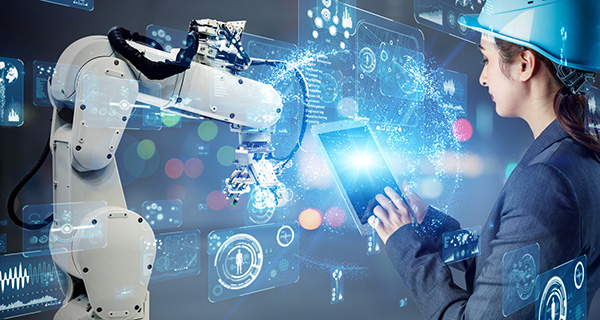Understanding the role of generative AI as the next digital disruption in manufacturing, as well as its challenges and opportunities.
By Vick Vaishnavi, CEO, ETQ
We’re in the throes of one of the most pivotal software revolutions to impact business and society alike, the advent of generative AI built upon large language models.
Generative AI is a form of artificial intelligence that “self-learns” via large amounts of publicly available data to generate new content in the form of text, images, video and other types of information. The speed at which it responds to natural language prompts to create highly relevant content is unprecedented.
Today, generative AI mostly creates content in response to natural language requests. Gartner, sees “generative AI becoming a general-purpose technology with an impact similar to that of the steam engine, electricity and the internet.”
Foundation models from generative AI systems, such as Open AI’s ChatGPT or Google Bard, can automate processes, aid humans or machines in their daily tasks and autonomously execute business and IT processes. They’re being used by businesses to generate marketing content and articles, develop customer communication and identify future trends. In software development they can be used to document software code, predict code sequences and automate key tasks. And, in manufacturing, they can be used for quality control, predictive maintenance and supply chain optimization.
While generative AI will play a major role in helping companies leverage the vast amounts of data available internally and across the world, as a nascent technology, there are obstacles that must be overcome. There’s currently no way to confirm the accuracy of artifacts it produces, nor a way to verify that it is presenting unbiased data. Additionally, there are fears that generative AI’s ability to create simulated imagery or mass communication could enable those with sinister intent to spread false information, or worse.
A Yale CEO Summit survey found that 42 percent of polled executives believe that AI has the potential to be an “extinction risk”, able to destroy humanity within ten years. Those extreme predictions have been refuted by the likes of Marc Andreesen and Bill Gates, who agree that generative AI needs to be managed, but that the benefits far outweigh the risks.
One interesting generative AI comparison Andreesen makes in this article is to other major societal disruptions. As we’re experiencing today, workers during the industrial revolution were concerned with machines taking away their jobs. According to Andreesen, when technology is applied to production, we get productivity growth, which results in lower prices for goods and services, and extra spending power with which to buy other things. By boosting the economy, it also drives the need for new production, “which then creates new jobs for the people who were replaced by machines.”
Another comparison to the opportunities that can come from technology disruption is the advent of the personal computer in the 1980s. Workers were afraid that PCs would make their work obsolete, but thousands of jobs were added because of PCs. From computer manufacturers to software developers, data scientists and others, an entire industry arose, giving people even more opportunities for fulfilling work. One last example is the advent of the Internet. It too caused fear that it would replace other modes of communication. It not only didn’t do that, but it ushered in new forms of communication on mobile devices, as well as social media.

While the benefits of generative AI are immense, it’s wise for businesses and governments alike to keep it in check. Sound and safe strategies for its use need to be implemented and if that means slowing down the process, it’s a risk worth taking. Yet as it evolves, what kind of a role can AI play in enabling greater overall quality in manufacturing?
Since AI is trained on massive data-sets using what are known as machine learning algorithms which allow it to predict future outcomes, it can help manufacturers make better, faster and more data-driven informed business decisions, such as anticipating supplier disruptions, optimizing production lines, reducing waste, or acting on customer feedback with product quality improvements, all resulting in multiple positive business outcomes. AI is doing this today, yet generative AI will enable a new level of intelligence. Consider the following use cases.
Documentation and content creation. With its ability to generate new content, generative AI will be able to instantly create training documentation, product user guides, documentation and much more, from simple or complex prompts.
Design. Since it’s not only text that it creates, generative AI will help with the design process of products, based on a set of rules and context. It can help to create new form factors and aesthetics for new or existing products.
Predictive maintenance. Generative AI also will help with predictive maintenance. Based on historical data, it will quite accurately predict when a system or equipment is likely to fail or impact safety, offer warnings and, in some cases, the actions needed to correct it.
Software development. Additionally, as manufacturers work to integrate systems enterprise-wide for visibility and cross-functional quality, generative AI will play a role in software coding and development, helping to allow critical systems to communicate, as well as to build new applications from scratch. In fact, a McKinsey study found that software developers can complete coding tasks up to twice as fast with generative AI.
Bridging the digital divide. Generative AI can help to bridge the gap for factory workers on the plant floor who may be experts in in their roles on the production line, or mechanics that acutely understand the workings of key equipment, yet struggle to embrace technology. They would be able to simply speak their request into a model and instantly receive feedback in the form of voice or text, whichever they prefer.
When it comes to the new era of generative AI, there’s a lot to digest. Most companies are wary of it and hopeful about it all at the same time. Yet, as with any new transformative technology, today’s manufacturers need to be open to the possibilities, understanding that it has the power to increase productivity, safety and quality, as long as it works alongside humans to support them, not as an opposing force.

Vick Vaishnavi, CEO, ETQ, is responsible for directing the company’s overall business strategy and operations, as it delivers quality management systems to leading manufacturers around the world. Vick can be reached at info@etq.com or 844- 293-3001.
In this episode, I sat down with Beejan Giga, Director | Partner and Caleb Emerson, Senior Results Manager at Carpedia International. We discussed the insights behind their recent Industry Today article, “Thinking Three Moves Ahead” and together we explored how manufacturers can plan more strategically, align with their suppliers, and build the operational discipline needed to support intentional, sustainable growth. It was a conversation packed with practical perspectives on navigating a fast-changing industry landscape.